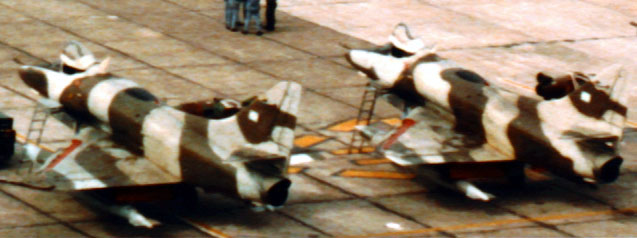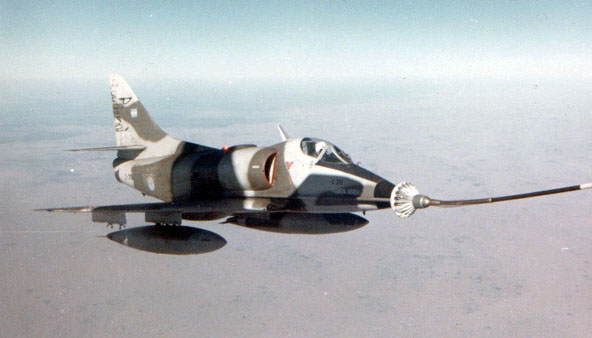|
|
 |
|
This 1987
upper view shows the upper camouflage scheme to advantage. The aircraft to
the right sports a somewhat distorted pattern, only seen on the final
airworthy examples |
Also there is one point that I have to mention that you may wish to consider if
going to paint a model of the Argentine A-4C: I have been lucky enough to have
seen an photographed A-4Cs on several occasions and standing before them I must
emphasize that the dark upper color I always saw was GREEN (with a brownish or
olive hue) and that the lighter color was always VERY LIGHT GREY (almost white)
and I mention this because I have noticed that when the aircraft were hit by
strong direct sunlight they LOOKED lighter and browner from a distance.
Argentine
A-4C Modifications |
One of the very peculiar things to the Argentine A-4Cs is that
they were modified with the external wing pylons which were only seen from the
A-4E model on. The modification included the addition of what seems to be a
reiforcing strip on top of the wing at the location where the pylon was below
and which necessitated the removal of one of the vortex generators.
Argentine A-4C Skyhawks always wore the national flag on the tail and the
roundel on the fuselage sides, but not on the wings to my knowledge.
The serials assigned were in the C-3xx range, from C-301 to
C-325. They were originally painted on the nose, rear fuselage sides and I have
seen photos with them on the upper right wing so I assume it was also on the
lower left ones too. They were black in small characters and the ones on the
nose sides were a little smaller than the rest and squarer in style.
|

|
|
In-flight
refuelling from a KC-130H before 1982 war. Note serials and black painted
nose cone |
The words FUERZA AEREA were painted in white below the nose
serial. After a period of tension with neighbouring Chile in 1978 the serials
were removed leaving only the national colors and white FUERZA AEREA and the
last two of the serial were painted under the nose in front of the nose landing
gear nose wheel well. It is interesting to note that the nose cones had
originally a large black area which was later consigned to the very tip, much as
could be seen on USN A-4Es. The fourth Air Brigade badge was always carried on
the left side of the nose.
Tactical Markings of the Falklands
War
By the time of the war yellow tactical markings were added under the wing tanks,
on the outer part of the wing pylons, as a band under the wings outside of the
inner wing pylons (although I still have to be 100%
convinced about this), as a band above the wing excluding the leading edge slat
and on the tail as a horizontal band without overpainting the flag (Mr.
Caruana´s drawing on SAMI shows the marking for an A-4B, which is unfortunately
not correct). These markings were overpainted with turquoise at some point
during the war and sometimes the yellow underneath showed through.
Post-Falklands Markings
Shortly after the war the A-4Cs were transferred to the fifth Air Brigade at
Coronel Pringles Air Base in the province of San Luis with the A-4Bs, and
acquired the badge of Fifth Fighter Group too. As only a few A-4Cs were by then
operational it was only every now and then that a "C" model was seen under
inspection and what had been a very constant finishing standard suffered
accordingly. One plane was seen and the end of their career with a medium grey
instead of the off-white upper color and the last two "C" flying examples during
the retirement ceremony were seen sporting plain and pure DARK GREEN and WHITE
colors!
Conclusion
and Acknowledgements |
Hopefully this short article and photos will enlighten someone who would still
think of a BROWN/SAND Argentine Air Force A-4C, but the decision will always be
yours!
I have not included war photos here because I do not have any good originals at
the time, but I hope to be coming back soon with them and also with some sort of
argentine A-4C walkaround.
I want to thank my friends Javier Mosquera and Luis Maria
Bonnani for their help in putting this article together. Some of the photos are
mine, some are Argentine Air Force official and that of the A-4B/C line
was taken by Carlos Ay.
Click the thumbnails below to view
the images full-sized:
|
|

|
|
Good upper view of one of the last A-4Cs with somewhat distorted camouflage and replacement ailerons from an A-4B. Very useful shot for the radome's shape.
|
|

|
|
Detail view of C-302 nose with two unit badges as used when moved to Villa Reynolds with the A-4Bs. |
|

|
|
Note the uniformity of schemes during the early days at Mendoza, with the serials still painted. Also note the lack of VLF/Omega antenna under the tail. It was a late modification.
|
|

|
|
The use of Magic AAM was only limited to trial flight on behalf of French company. The same machine also tested the Belouga bomb. None of these weapons ever entered service with Argentine A-4s.
|
|

|
|
Very clear shot of C-302 in the late 80's.
|
|
|
Text & Images Copyright © 2001 by
Jorge Figari
Page Created 19 October, 2001
Last Updated
19 April, 2004
Back to Reference Library
|
Home |
What's New |
Features |
Gallery |
Reviews |
Reference |
Forum |
Search